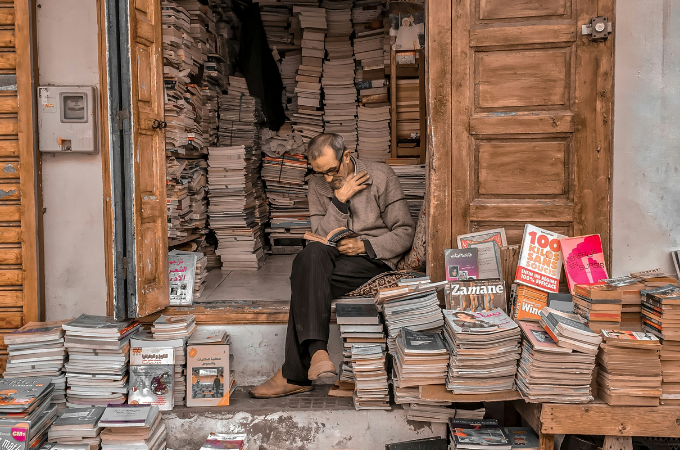
I eagerly headed to the book shop as soon as I heard that Mũkoma wa Ngũgĩ’s book, The Rise of the African Novel, was available for purchase. Throughout the short journey, a melody continuously replayed itself in my head, keeping me company. This melody comes from Countee Cullen’s lines of his well-known poem “Heritage”:
One three centuries removed
From the scenes his fathers loved,
Spicy grove, cinnamon tree,
What is Africa to me?
Wa Ngũgĩ devoted his book to answering some crucial questions about the African novel, the African writer, and primarily the situation of the African languages. As its title might suggest, the book traced the rise of the African novel from its very beginning, focusing on the actual significant and pivotal point in its path, which is the Makerere conference in 1962, with the presence and participation of prominent African writers such as Chinua Achebe, Wole Soyinka, Obi Wali, and Ngũgĩ wa Thiong’o, to name but a few. As I leafed through the papers, reading line after line, paragraph after paragraph, and chapter after chapter, small striking questions began to form in my mind: Isn’t Morocco an African country, and its literature an integral part of African literature as well? Aren’t Moroccans speaking an African language?
Morocco’s strategic location has historically served as a place of cultural exchange, making it a pivotal contact zone. It is situated in the north-west of the African continent, forming a window that overlooks the African world. Nevertheless, it appears that Morocco’s proximity to the European continent and frequent interactions with westerners thrust it into an interstitial space, a third space between the European pole and the African pole. The Moors, with their skin too light for an African and too dark for a European, find themselves in the middle, enduring both rejections. They suffered from colonization as other African countries and underwent the horrors of imperial greed of the westerners, but they did not experience the dark ages of slavery and racism that were against black skin Africans. This raises the question of what does it mean to be African?
It is completely understandable the repetition of some African languages in the book, such as Igbo, Yoruba, Hausa, and Swahili, as the last one is the second most widely spoken language in Africa. What is unfathomable is the absence of Arabic, the most widely spoken language on our continent. Perhaps this language’s omission is due to its origin, the Arabian Peninsula, in Asia. Therefore, it is difficult to classify it as an African language, regardless of its long history in Africa. However, the Arabic language Moroccans (North Africans) speak is heavily influenced by their original African language, Tamazight. A language that survived waves of eastern and western storms that intended to bury it alive. With the unstoppable march of time and the arrival of different nations to Morocco with different intentions and purposes, the external part of the tongue of the Moors was continuously reshaped by this variety of visitors.
The current of the language issue in Morocco is strong enough to drift us away from the essay’s mainstream and aim. To be faithful to the topic, the matter ought to be summed up in the following few sentences. The Moors devotedly preserved their mother tongue, Tamazight, and used it in their daily interactions as their ancestors did for decades. They made it their official national language, along with Arabic. The confusion lies in the fact that Arabic is employed as a functional language in Morocco and utilized in international relations beside French and English. Unlike Tamazight, which traveled only verbally and between tongues of the North Africans, that may be the reason behind the exclusion that befalls this important language in the book. Accordingly, based on the language used, North African literature is divided into two categories. The first category contains the compositions written in non-African languages, mainly French, Arabic, and English. While the second group consists of folk stories that have been transmitted orally in Tamazight.
This complexity around the Moroccan nation is well reflected in their literature and art in general. In the late years of colonization (1950’s), the intellectuals, namely Ahmed Sefrioui and Driss Chraïbi, started the ritual of writing and publishing novels in French, and many after them followed their path. Despite the Arabic novels emerging years before the French ones and containing a comparable number of pieces, the former were widely disseminated and extensively read due to the educational system and the reading habits of the readership. In recent years, English novels written by relatively young intellectuals, such as Laila Lalami, have begun to book their place on the Moroccan shelf alongside French and Arabic. Yet Morocco’s original language, Tamazight, has not joined the race to this today and is still in the preparation phase. Nevertheless, the various languages used to transmit Moroccan culture and experience serve to enrich Moroccan literature.
The phrase ‘African literature’ instantly brings to mind Things Fall Apart, The Beautyful Ones Are Not Yet Born, Half of a Yellow Sun, and many other great novels, but you never immediately think of any piece written by a Moroccan author (or any North African one, not even the Egyptian Nobel Prize winner, Naguib Mahfouz). And when you hear ‘Moroccan literature,’ your mind conjures up pictures of For Bread Alone, This Blinding Absence of Light, Year of the Elephant, and other phenomenal works that are no less astonishing than the ones mentioned earlier. I believe that the term ‘African literature’ serves to satisfy the western gaze on our continent and confine African creativity, excluding any art that may deviate from its established boundaries. The term ought to be dismissed and replaced when talking about a novel with the nation the author belongs to. For example, when you hear War and Peace, you immediately think of Russian literature rather than European literature, for it is admittedly part of European literature. Thus, No Longer at Ease is a Nigerian masterpiece, and The Sand Child is a Moroccan masterpiece that both admittedly belong to and are integral parts of African literature.
I would like to devote my last paragraph to name some distinguished Moroccan writers and their major works:
Mohammed Khaïr-Eddine – Il etait une fois un couple heureux
Fatema Mernissi – Dreams of Trespass
Mohamed Choukri – For Bread Alone (الخبز الحافي)
Leila Abouzeid – Return to Childhood ( الرجوع إلى الطفولة)
Tahar Ben Jelloun – The Sand Child (l’Enfant de sable)
Mohamed Zafzaf – An Attempt at Life (محاولة عيش)
Photo by HamZa NOUASRIA on Unsplash










COMMENTS -
Reader Interactions